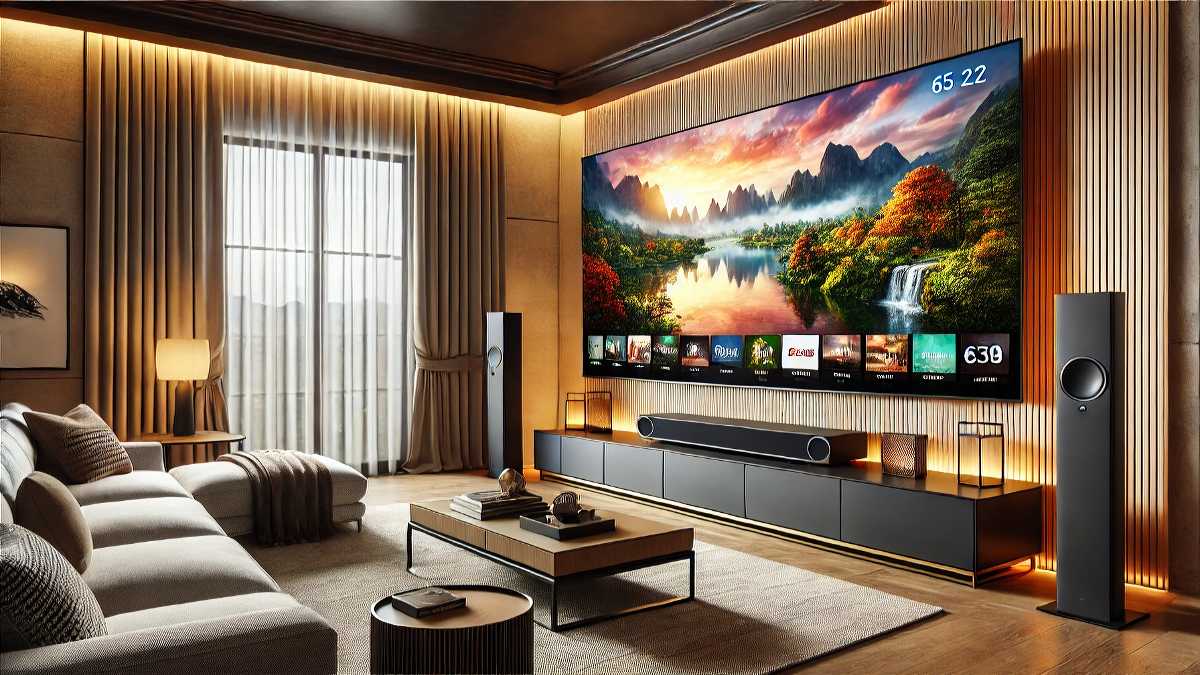Introduction
A 65-inch TV is a popular choice for home entertainment, offering an immersive viewing experience. But before buying, it’s essential to understand its dimensions, the optimal viewing distance, and how it fits into different spaces. This guide provides a comprehensive breakdown of a 65-inch TV’s size, placement considerations, and buying tips.
What Are the Dimensions of a 65 Inch TV?
A 65-inch TV refers to the screen’s diagonal measurement. However, actual width, height, and depth vary slightly by brand and model. Below are the typical dimensions:
| Measurement | Size (Approximate) |
|---|---|
| Diagonal | 65 inches |
| Width | 56.7 inches (144 cm) |
| Height | 31.9 inches (81 cm) |
| Depth (Without Stand) | 2-3 inches (5-7 cm) |
| Depth (With Stand) | 10-12 inches (25-30 cm) |
Frame Thickness Consideration
Newer OLED and QLED models feature ultra-thin designs, while LED TVs may have slightly thicker bezels.
Best Viewing Distance for a 65 Inch TV
Optimal viewing distance depends on resolution and personal comfort. Here’s a general guideline:
| Resolution | Ideal Viewing Distance |
| 1080p (Full HD) | 8.1 – 13.5 feet |
| 4K (Ultra HD) | 5.4 – 8.1 feet |
| 8K (Super UHD) | 3.5 – 5.4 feet |
Sitting too close may cause eye strain, while sitting too far reduces clarity and detail.
Is a 65 Inch TV Right for Your Room?
Room Size and Placement
To determine whether a 65-inch TV is a good fit, consider the available wall or stand space:
- Living Rooms: Ideal for medium-to-large living spaces with at least 7 feet of viewing distance.
- Bedrooms: May be too large unless you have ample space and plan to mount it on a wall.
- Home Theaters: Works best when paired with a sound system and ambient lighting control.
Wall Mount vs. TV Stand
- Wall Mount: Saves space, improves aesthetics, and allows for adjustable angles.
- TV Stand: Offers flexibility but requires additional floor space.
How to Choose the Best 65 Inch TV?
Key Features to Consider
- Resolution: 4K is the standard, but 8K offers future-proofing.
- Panel Technology: OLED for best contrast, QLED for vibrant colors, and LED for budget-friendly options.
- Refresh Rate: 120Hz is ideal for gaming and fast-action scenes.
- HDR Support: HDR10+ and Dolby Vision enhance color accuracy and brightness.
- Smart Features: Ensure compatibility with streaming apps like Netflix, Hulu, and Disney+.
Recommended 65 Inch TV Models (2025)
| Brand & Model | Panel Type | Resolution | Price Range |
| Samsung QN90B | QLED | 4K | $1,200-$1,600 |
| LG C3 OLED | OLED | 4K | $1,500-$2,000 |
| Sony A80K | OLED | 4K | $1,700-$2,200 |
| TCL 6-Series | Mini-LED | 4K | $900-$1,300 |
Pros and Cons of a 65 Inch TV
Pros:
✅ Large screen for immersive experience
✅ Perfect for movie nights and gaming
✅ Available in various resolutions and display technologies
✅ Ideal balance between size and affordability
Cons:
❌ May be too big for small rooms
❌ Requires proper wall support for mounting
❌ Higher energy consumption compared to smaller TVs

FAQ Section
1. How far should I sit from a 65-inch TV?
For a 4K TV, the ideal viewing distance is around 5.4 – 8.1 feet.
2. Can a 65-inch TV fit on my stand?
Ensure your TV stand is at least 57 inches wide to accommodate the TV’s base.
3. Is a 65-inch TV too big for gaming?
No, it provides an immersive experience, especially with high refresh rates (120Hz).
4. Do I need a soundbar for a 65-inch TV?
Built-in speakers are often insufficient. A soundbar or home theater system is recommended.
5. Is a 65-inch TV good for sports?
Yes, especially models with a high refresh rate and motion smoothing technology.
6. Should I buy an OLED or QLED 65-inch TV?
OLED offers superior contrast, while QLED provides brighter displays. Choose based on your lighting environment.
Conclusion
A 65-inch TV is a fantastic choice for home entertainment, provided you have the right space and viewing distance. Whether for movies, sports, or gaming, choosing the right model and features will enhance your viewing experience. Consider resolution, panel type, and placement before making a purchase.

